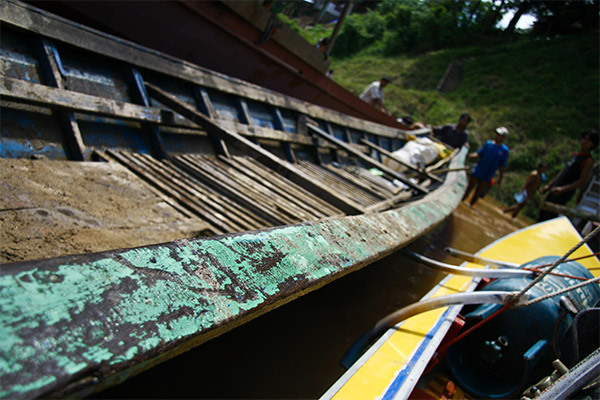A meander up the Mekong
The wooden boat is long—probably three metres—and thin. Its sides rise up to my shoulders, but that’s because I’m sitting on the floor, knees to my chest. I’m at the back and two others—separated by a piece of wooden framing—are in front of me. In front of them, a pile of packs covered in black plastic bags (those belong to the undergrads) or water resistant covers (the postgrads who’ve made the trip before). We wear old motorbike helmets tied under our chins with the visors down in anticipation of the spray. Between by knees and face I balance my small day pack, careful not to lose it to the river. It holds, among other things, an ambitious purchase: a book, bought a few days earlier and so far unread—our journey has consisted of one bumpy ride after another, all transport either propelled by some kind of unreliable machinery or pulled by animals.
There’s a group of us, enough to fill four of these boats. A driver at the back of each boat is pushed up against the last two people and holds on with one hand. His other hand rests on the throttle, a piece of wood attached to an outboard motor scavenged from an old lawnmower. The violent noise interrupts the Mekong’s slow trawl south as we ride north, to the jungle in Laos. It rains.
Time is constant, unkempt, the river guiding movement, guiding the people on its banks, and everything seems to whirr.Bugs caught in gusts stick to the wet of my helmet. Occasionally, I watch a fish jump skywards, silver turning dirt orange as it continues to swim. The river sprays our faces with its dark orange wetness and the damp of my left arm, close to the water, spreads slowly across my chest. I enjoy the feeling of being wet and dirty without inviting contempt.
The girl seated next to me yells above the sound of the outboard motor, but mostly we’re alone in our rectangles, each of us looking out at the river as we wind through steep cliffs and dirty sand beaches with jungles running off them.
Halfway along the eight-hour journey we break at a small hut on the river for bai lieng (fried rice, a recent staple of our diet). The driver’s shirt flaps against my helmet as we slow. He and those who, like him, learn the life-sustaining river’s bends have an economic dedication. People in wooden huts buoyed up with straw and plastic drums live atop the river further south, floating towns with cages of crocodiles and submerged containers of cramped fish—foreign amusement. The river has created an ecosystem of people above its aquatic community. Men fish and children swim naked while babies sleep in hammocks strung above broken timber slats that show through to the water a few feet below.
The river is a trans-boundary snake intersecting Vietnam, Laos, Thailand and Cambodia. We resume our ride on it. Rapids flow in little peaks over rocks submerged under the murky water, invisible to us as we zigzag them. Time is constant, unkempt, the river guiding movement, guiding the people on its banks, and everything seems to whirr.
The wind increases and the boat picks up speed to compensate, revving hard against small swells that propel us in a jump forward before the boat noses the next one. The sameness of the colours is comforting, slabs of dark grey sky broken by green jungle and rock. Around us, noises of foreign insects, felt things, cracks in the clouds letting the light stream out above the jungle. Our senses that were not long ago surprised by the unfamiliar have become comfortable in the slap of the boat on rough water.
The slowness of a two-stroke motor on the Mekong, the submergence into a foreign space. Smooth travel doesn’t catch in your throat and jerk like the outboard motor spitting petrol and water. The art of travel—to be lost from time—achieved in wet solicitude with flying fish.
Photograph
Share

